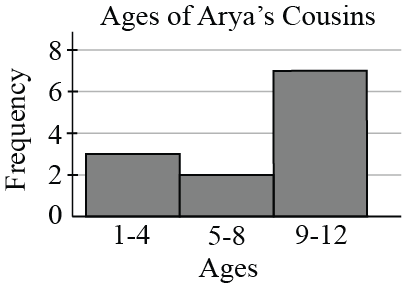

Arya has twelve cousins. She secretly writes their ages, as positive integers, on a piece of paper. She then tells you the mean (average) of the twelve ages is \(8.75\) and the median is \(10\). Finally, she draws you the following histogram to represent the ages of her cousins.

How many possibilities are there for the ages of Arya’s twelve cousins?
Since there are \(12\) ages, the median will be the number halfway between the sixth and seventh ages when they are arranged in increasing order. From the histogram, we know that the sixth and seventh ages are both between \(9\) and \(12\). Since the median is \(10\), it follows that the sixth and seventh ages are either \(9\) and \(11\), respectively, or they are both \(10\).
Since the mean of the \(12\) ages is \(8.75\), it follows that the sum of all \(12\) ages is \(8.75\times 12=105\). We know from the previous paragraph that the sixth and seventh ages are either \(9\) and \(11\), respectively, or they are both \(10\). Either way, their sum is \(20\). So the sum of the remaining ten ages is \(105-20=85\). From the histogram, we know that three of these ages are between \(1\) and \(4\), two of these ages are between \(5\) and \(8\), and the remaining five are between \(9\) and \(12\) and also greater than the seventh age, which is either \(10\) or \(11\).
We will consider cases by looking at the possible sums of the five smallest ages.
Case 1: The sum of the five smallest ages is \(28\).
This is the maximum possible sum of the five smallest ages, and occurs when the ages are \(4,4,4,8,8\). The corresponding sum of the five largest ages is then \(85-28=57\).
If the seventh age is \(10\), then the five largest ages could be \(10,11,12,12,12\) or \(11,11,11,12,12\). Thus, there are \(2\) possibilities for the ages of Arya’s cousins.
If the seventh age is \(11\), then the five largest ages could only be \(11,11,11,12,12\). Thus, there is \(1\) possibility for the ages of Arya’s cousins.
In total, there are \(2+1=3\) possibilities for the ages of Arya’s cousins if the sum of the five smallest ages is \(28\).
Case 2: The sum of the five smallest ages is \(27\).
This occurs when the ages are \(3,4,4,8,8\) or \(4,4,4,7,8\). The corresponding sum of the five largest ages is then \(85-27=58\).
If the seventh age is \(10\), then the five largest ages could be \(10,12,12,12,12\) or \(11,11,12,12,12\). Thus, there are \(2\) possibilities for the five smallest ages and \(2\) possibilities for the five largest ages, which results in \(2\times 2=4\) possibilities for the ages of Arya’s cousins.
If the seventh age is \(11\), then the five largest ages could only be \(11,11,12,12,12\). Thus, there are \(2\) possibilities for the five smallest ages and \(1\) possibility for the five largest ages, which results in \(2\times 1=2\) possibilities for the ages of Arya’s cousins.
In total, there are \(4+2=6\) possibilities for the ages of Arya’s cousins if the sum of the five smallest ages is \(27\).
Case 3: The sum of the five smallest ages is \(26\).
This occurs when the ages are \(2,4,4,8,8\) or \(3,3,4,8,8\) or \(3,4,4,7,8\) or \(4,4,4,6,8\) or \(4,4,4,7,7\). The corresponding sum of the five largest ages is then \(85-26=59\). The only possibility for the five largest ages is \(11,12,12,12,12\). Thus, there are \(5\) possibilities for the five smallest ages, \(2\) possibilities for the two middle ages, and \(1\) possibility for the five largest ages, which results in \(5\times 2\times 1=10\) possibilities for the ages of Arya’s cousins if the sum of the five smallest ages is \(26\).
Case 4: The sum of the five smallest ages is \(25\).
This occurs when the ages are \(1,4,4,8,8\) or \(2,3,4,8,8\) or \(2,4,4,7,8\) or \(3,3,3,8,8\) or \(3,3,4,7,8\) or \(3,4,4,6,8\) or \(3,4,4,7,7\) or \(4,4,4,5,8\) or \(4,4,4,6,7\). The corresponding sum of the five largest ages is then \(85-26=60\). This is the maximum possible sum of the five largest ages and occurs when the ages are \(12,12,12,12,12\). Thus, there are \(9\) possibilities for the five smallest ages, \(2\) possibilities for the two middle ages, and \(1\) possibility for the five largest ages, which results in \(9\times 2\times 1=18\) possibilities for the ages of Arya’s cousins if the sum of the five smallest ages is \(25\).
Therefore, in total, there are \(3+6+10+18=37\) possibilities for the ages of Arya’s twelve cousins.